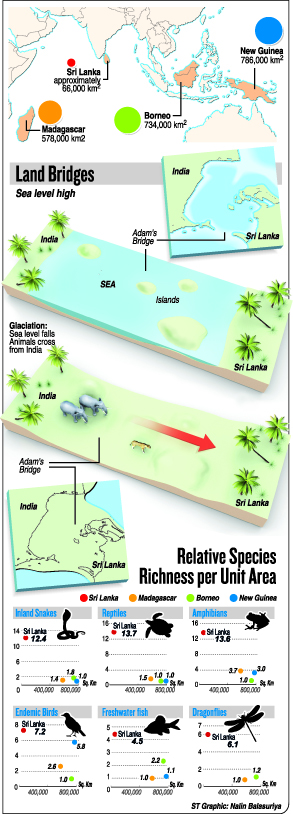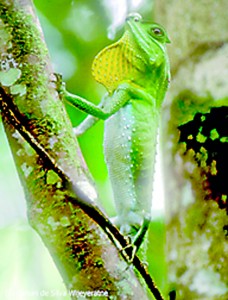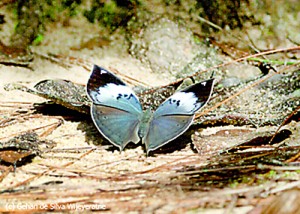Why Sri Lanka is super-rich for wildlife
This is the story of how ice and ancient civilisations with evolutionary forces have made a tropical island super-rich for wildlife on a scale that is not seen anywhere on moderately or large islands. Sri Lanka’s super-richness on a proportionate scale eclipses large islands such a Madagascar, Borneo and New Guinea.
 Alfred Russell Wallace the founder of modern biogeography and Charles Darwin with whom he shared the theory of evolution were both influenced by what they had observed on islands. They both would have been surprised by Sri Lanka. Almost every key driver of evolution seems to have played a part in shaping its biodiversity. The result is an island which is rich in wildlife both in terms of endemic tropical biodiversity as well as large land animals and marine mammals and in concentrations which give rise to some of the world’s most interesting wildlife spectacles.
Alfred Russell Wallace the founder of modern biogeography and Charles Darwin with whom he shared the theory of evolution were both influenced by what they had observed on islands. They both would have been surprised by Sri Lanka. Almost every key driver of evolution seems to have played a part in shaping its biodiversity. The result is an island which is rich in wildlife both in terms of endemic tropical biodiversity as well as large land animals and marine mammals and in concentrations which give rise to some of the world’s most interesting wildlife spectacles.

A Hump-nosed lizard
It’s an island which Wallace and Darwin or modern biologists could not have imagined as so many of the bio-geographical and evolutionary forces have come into play simultaneously, to create an unrivalled richness. To top it all, it’s a compact country with good tourism infrastructure making it optimal for wildlife tour operators. This article is about the physical, evolutionary, and human factors that have made Sri Lanka something seemingly imaginary, but yet real.
In a previous article in this newspaper (January 13, 2013) I explained why Sri Lanka has a claim to be the best all-round wildlife destination from a wildlife tour operator’s perspective. In this article I explain the physical, evolutionary and human-induced forces that have made this happen. In essence, I would simplify it conceptually into a three part ‘business model’ for the creation of a top wildlife destination. The first is a set of physical factors, especially those influencing both surface and underwater topography. These together with other planetary phenomena such as plate tectonics and monsoons create structural or topographical complexity on land and under water.
Together with time, the topographical or structural complexity on land with monsoonal rainfall has led to the creation of distinct climatic (and hence ecological) zones that are the engine for speciation. Sri Lanka has benefitted from other physical factors such as an ancient Gondwana start and having deep seas close to it unlike other continental islands.
Having set up the right conditions for evolutionary factors, the engine of speciation needs to be fed with raw material. The output of the species production factory will be enhanced if besides the operation of long intervals of evolutionary time scales, new species production is boosted by fresh stocks of mainland species through immigrant waves. Sri Lanka has managed to produce a phenomenally above normal species richness (see box story) primarily from evolutionary radiations within the island resulting in endemic genera and species and later by supplementing it by land-bridging repeatedly with the mainland. This has become more apparent recently through phylogenetic studies using DNA. I would describe this as a five stage process for building up the number of species.
During periods of glaciations, water is deposited as ice on land and sea levels fall forming a land bridge in the shallow seas. This is still physically evident in the discontinuous land bridge between Mannar and India, known as Adam’s Bridge. New waves of immigrants are imported to the island via the land bridge and dispersed and then isolated by rising sea levels drowning the land bridge during warming after an ice age (a post glacial). The new arrivals are physically stressed into niches by complex structural and physical factors of topography and climate. In essence the process is connect– import and disperse– isolate–stress–speciate. Glaciations have been a key agent of the island’s super-richness in allowing large land mammals to colonise and persist in Sri Lanka. However, phylogenetic studies indicate that most of the radiations of endemic species occurred before the land bridge connections of the Pleistocene epoch in the Quarternary.
The third of the large scale factors is that it has benefitted from human factors or a cultural overlay. The last has two aspects. Firstly, the decline of ancient kingdoms has resulted in great seasonal gatherings of wild elephants and one of the best sites for Leopards. This creates wildlife spectacles which make great viewing on wildlife safaris. (These spectacles have also been complemented by evolutionary factors mentioned above resulting in species radiations which are of great scientific interest even though species such as amphibians are not high on the list of commercial wildlife safaris). The second aspect of the cultural overlay is that the deep respect for life makes wildlife viewing easy as man and animals co-exist with great tolerance.
(Next week: The three factor ‘business model’ that has been at work to create this extraordinary richness)


